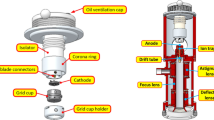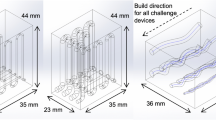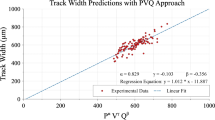Abstract
Plasma transferred arc additive manufacturing (PTA-AM) is a high volume and high speed directed energy deposition (DED) technique that uses metal powder as a feedstock material to build up 3-dimensional (3D) components, layer by layer. In the PTA-AM process, the quality of the build is a function of several parameters, including but not limited to the powder feed rate, the torch travel speed, stand-off distance (SOD), and plasma arc current. Unlike the laser DED systems, the melt pool and laser visualization are not possible through inline imaging systems. These processes have difficulty sustaining uniform evenly distributed powder flow between the nozzle and the substrate. For the constant operating parameters, the process requires in-depth attention to inspect the quality and geometrical features of bead deposition, which may alter due to continuous mechanical connection with the deposition process. Surprisingly, no work is reported in plasma-based DED systems to determine the process parameter influence on build quality using image processing technique. Therefore, in this work, high-speed imaging is employed to analyze and quantify the process parameters of the PTA-AM and their effects on the bead quality and geometry. The experiments of single-track multi-layer bead deposition of Tungsten Carbide (WC)-reinforced NiCrBSi composites are carried out and recorded with a high-speed camera. Based on captured 2D image data, the image processing techniques are developed using Matlab and Image-Pro premier software. The proposed techniques optimize and validate the SOD to print the stable bead and maintain the higher powder catchment efficiency at the deposition zone. It is also used to assess the process stability (uniform powder flow) and the impact of powder flow variation on the bead height. The powder stream distribution, the statistical dispersion of powder particle count, and their effect on the build quality are described based on powder flow images, using an image processing approach. The significance of relationships between bead height variation and powder particle counts is analyzed using statistical methodologies such as analysis of variance (ANOVA) and two-tailed t-test. The effect of PTA-AM process parameters on bead geometry reveals that the plasma arc current and powder particle count significantly affect the bead geometry. This work validates the benefit of using 7-mm SOD for improving part quality. Using image analysis, the uniformity of powder flow is evaluated. In addition, the finding shows that the increment in plasma current by 40% increases the mean bead width by 85% and decreases its height by 24%. By determining the effect of processing parameters on the bead quality and geometry, this PTA-AM process can build near-net-shape parts and increase the reliability and reproducibility of the process. Thus, the proposed in situ image processing methods can be adopted in the PTA-AM process to analyze manufactured parts’ quality and characterize the process parameters responsible for the deviation in surface quality and dimensional geometry.














Similar content being viewed by others
Data availability
Data generated and/or analyzed during the current study may be obtained from the corresponding author upon reasonable request.
References
Mazumder J (2015) Design for metallic additive manufacturing machine with capability for “certify as you build.” Procedia CIRP, 36(Dmd), 187–192. https://doi.org/10.1016/j.procir.2015.01.009.
Thompson SM, Bian L, Shamsaei N, Yadollahi A (2015) An overview of Direct Laser Deposition for additive manufacturing; Part I: Transport phenomena, modeling and diagnostics. Addit Manuf 8:36–62. https://doi.org/10.1016/j.addma.2015.07.002
Ding D, Pan Z, Cuiuri D, Li H (2015) Wire-feed additive manufacturing of metal components: technologies, developments and future interests. Int J Adv Manuf Technol 81(1–4):465–481. https://doi.org/10.1007/s00170-015-7077-3
Andersson J (2020) Welding metallurgy and weldability of superalloys. Metals, 10(1). https://doi.org/10.3390/met10010143.
Cunningham R, Nicolas A, Madsen J, Fodran E, Anagnostou E, Sangid MD, Rollett AD (2017) Analyzing the effects of powder and post-processing on porosity and properties of electron beam melted Ti-6Al-4V. Materials Research Letters 5(7):516–525. https://doi.org/10.1080/21663831.2017.1340911
Wu B, Pan Z, Ding D, Cuiuri D, Li H, Xu J, Norrish J (2018) A review of the wire arc additive manufacturing of metals : properties, defects and quality improvement. J Manu Process 35(August), 127–139.https://doi.org/10.1016/j.jmapro.2018.08.001.
Dass A, Moridi A.(2019) State of the art in directed energy deposition: from additive manufacturing to materials design. 1–26. https://doi.org/10.3390/coatings9070418
Tan H, Zhang F, Fu X, Meng J, Hu G, Fan W, Huang W (2016) Development of powder flow model of laser solid forming by analysis method. Int J Adv Manuf Technol 82(5–8):1421–1431. https://doi.org/10.1007/s00170-015-7481-8
Gong X, Wang J, Feng H (2019) Lateral powder transport model with Gaussian distribution in laser cladding. Int J Adv Manu Tech 02(9–12), 3747–3756.https://doi.org/10.1007/s00170-019-03499-3.
Mahmood MA, Popescu AC, Oane M, Ristoscu C, Chioibasu D, Mihai S, Mihailescu IN (2020) Three-jet powder flow and laser–powder interaction in laser melting deposition: Modelling versus experimental correlations. Metals 10(9), 1–17. https://doi.org/10.3390/met10091113.
Parekh R, Buddu RK, Patel RI (2016) Multiphysics simulation of laser cladding process to study the effect of process parameters on clad geometry. Procedia Technol 23:529–536. https://doi.org/10.1016/j.protcy.2016.03.059
Ferreira E, Dal M, Colin C, Marion G, Gorny C, Courapied D, Peyre P (2020) Experimental and numerical analysis of gas/powder flow for different LMD nozzles. Metals 10(5):667. https://doi.org/10.3390/met10050667
Saqib S, Urbanic RJ, Aggarwal K (2014) Analysis of laser cladding bead morphology for developing additive manufacturing travel paths Design of Experiments. Procedia CIRP 17:824–829. https://doi.org/10.1016/j.procir.2014.01.098
Caiazzo F, Caggiano A (2018) Laser direct metal deposition of 2024 al alloy: Trace geometry prediction via machine learning. Materials, 11(3). https://doi.org/10.3390/ma11030444.
Tang Z, Liu J, Wang W, Wen Y, Saleheen KM, Liu Z, Chao P, Tong S, Zhang H, Chao H (2020) A review on in situ monitoring technology for directed energy deposition of metals. Int J Adv Manuf Technol 108(11–12):3437–3463. https://doi.org/10.1007/s00170-020-05569-3
Galati M, Iuliano L (2018) A literature review of powder-based electron beam melting focusing on numerical simulations. Additive Manufacturing 19, 1–20.https://doi.org/10.1016/j.addma.2017.11.001
Soylemez E, Beuth JL, Taminger K (2010) Controlling melt pool dimensions over a wide range of material deposition rates in electron beam additive manufacturing. 21st Annual International Solid Freeform Fabrication Symposium - An Additive Manufacturing Conference, SFF 2010, (January 2010), 571–582.
Kuchi SC (2009) Effect of finite geometry on solidification microstructure in beam-based fabrication of thin wall structures (Doctoral dissertation, Wright State University).
Wallace TA, Bey KS, Taminger KM, Hafley RA (2004) A design of experiments approach defining the relationships between processing and microstructure for Ti-6Al-4V. In 2004 Int Solid Freeform Fabric Symp.
Gockel J, Beuth J, Taminger K (2014) Integrated control of solidification microstructure and melt pool dimensions in electron beam wire feed additive manufacturing of Ti-6AI-4V. Addit Manuf 1–4:119–126. https://doi.org/10.1016/j.addma.2014.09.004
Yao M, Yao Z, Tao X, Moliar O (2020) Effect of deposition modes on electron beam directed energy deposited inconel 718. https://doi.org/10.1080/02670836.2020.1802838.
Seufzer WJ, Taminger KM (2007) Control of space-based electron beam free form fabrication.
Li F, Chen S, Shi J, Zhao Y, Tian H (2018) Thermoelectric cooling-aided bead geometry regulation in wire and arc-based additive manufacturing of thin-walled structures. Appl Sci 8(2):207. https://doi.org/10.3390/app8020207
Dinovitzer M, Chen X, Laliberte J, Huang X, Frei H (2019) Effect of wire and arc additive manufacturing (WAAM) process parameters on bead geometry and microstructure. Additive Manufac 26(October 2018), 138–146. https://doi.org/10.1016/j.addma.2018.12.013
Wang H, Jiang W, Ouyang J, Kovacevic R (2004) Rapid prototyping of 4043 Al-alloy parts by VP-GTAW. J Mater Process Techn 148(1), 93–102. https://doi.org/10.1016/j.jmatprotec.2004.01.058.
Rodrigues TA, Duarte V, Miranda RM, Santos TG, Oliveira JP(2019) Current status and perspectives on wire and arc additive manufacturing (WAAM). Materials 12(7). https://doi.org/10.3390/ma12071121.
Karmuhilan M, Kumar A (2018) ScienceDirect Intelligent process model for bead geometry prediction in WAAM. Materials Today: Proceedings 5(11):24005–24013. https://doi.org/10.1016/j.matpr.2018.10.193
Ding D, Pan Z, Cuiuri D, Li H, Duin S Van, Larkin N (2016) Robotics and computer-integrated manufacturing bead modelling and implementation of adaptive MAT path in wire and arc additive manufacturing. Robot Comp Integrate Manufac 39, 32–42. https://doi.org/10.1016/j.rcim.2015.12.004.
Alberti EA, Bueno BMP, Oliveira ASCMD (2016) Additive manufacturing using plasma transferred arc. 1861–1871. https://doi.org/10.1007/s00170-015-7697-7.
Vály L, Grech D, Neubauer E, Kitzmantel M, Bača Ľ, Stelzer N (2017) Preparation of titanium metal matrix composites using additive manufacturing. 742, 129–136.https://doi.org/10.4028/www.scientific.net/KEM.742.129.
Perez-Soriano EM, Ariza E, Arevalo C, Montealegre-Melendez I, Kitzmantel M, Neubauer E (2020) Processing by additive manufacturing based on plasma transferred arc of hastelloy in air and argon atmosphere. Metals 10(2). https://doi.org/10.3390/met10020200.
Rodriguez J, Hoefer K, Haelsig A, Mayr P (2019) Functionally graded SS 316L to Ni based structures produced by 3D plasma metal deposition. Metals 9(6):620. https://doi.org/10.3390/met9060620
Lakshminarayanan AK, Balasubramanian V, Varahamoorthy R, Babu S (2008) Predicting the dilution of plasma transferred arc hardfacing of stellite on carbon steel using response surface methodology. Metals and Mater Int 14(6), 779–789. https://doi.org/10.3365/met.mat.2008.12.779.
Wang C, Suder W, Ding J, Williams S (2021) The e ff ect of wire size on high deposition rate wire and plasma arc additive manufacture of Ti-6Al-4V. J Mater Process Tech 288(April 2020), 116842. https://doi.org/10.1016/j.jmatprotec.2020.116842.
Mercado Rojas JG, Wolfe T, Fleck BA, Qureshi AJ (2018) Plasma transferred arc additive manufacturing of Nickel metal matrix composites. Manufac Letters 18, 31–34. https://doi.org/10.1016/j.mfglet.2018.10.001.
Rojas JGM, Ghasri-Khouzani M, Wolfe T, Fleck B, Henein H, Qureshi AJ (2021) Preliminary geometrical and microstructural characterization of WC-reinforced NiCrBSi matrix composites fabricated by plasma transferred arc additive manufacturing through Taguchi-based experimentation. The Int J Adv Manu Tech 113(5), 1451–1468. https://doi.org/10.1007/s00170-020-06388-2.
El Moghazi SN, Wolfe T, Ivey DG, Henein H (2020) Plasma transfer arc additive manufacturing of 17–4 PH: assessment of defects. The international journal of advanced manufacturing technology 108:2301–2313. https://doi.org/10.1007/s00170-020-05540-2
Nikam SH, Jain NK (2018) 3D-finite element simulation and image processing based prediction of width and height of single-layer deposition by micro-plasma-transferred arc process. The Int J Adv Manu Tech 95(9), 3679–3691. https://doi.org/10.1007/s00170-017-1472-x.
Nikam SH, Jain NK, Jhavar S (2016) Thermal modeling of geometry of single-track deposition in micro-plasma transferred arc deposition process. J Mater Process Tech 230, 121–130.https://doi.org/10.1016/j.jmatprotec.2015.11.022.
Jhavar S, Jain NK, Paul CP (2014) Development of micro-plasma transferred arc (μ-PTA) wire deposition process for additive layer manufacturing applications. J Mat Process Tech 214(5), 1102–1110.https://doi.org/10.1016/j.jmatprotec.2013.12.016.
Sawant MS, Jain NK (2018) Investigations on additive manufacturing of Ti–6Al–4V by microplasma transferred arc powder deposition process. J Manuf Sci Eng 140(8):081014. https://doi.org/10.1115/1.4040324
Liyanage T, Fisher G, Gerlich AP (2012) Microstructures and abrasive wear performance of PTAW deposited Ni–WC overlays using different Ni-alloy chemistries. Wear 274, 345–354.https://doi.org/10.1016/j.wear.2011.10.001.
Vetter PA, Engel T, Fontaine J (1994) Laser cladding: the relevant parameters for process control. In Laser Materials Processing: Industrial and Microelectronics Applications (Vol. 2207, pp. 452–462). Int Society Opt Photonhttps://doi.org/10.1117/12.184751.
Toyserkani E, Khajepour A, Corbin SF (2004) Laser cladding. CRC Press
Liu WW, Tang ZJ, Liu XY, Wang HJ, Zhang HC (2017) A review on in-situ monitoring and adaptive control technology for laser cladding remanufacturing. Procedia Cirp 61:235–240. https://doi.org/10.1016/j.procir.2016.11.217
Łatka L, Biskup P (2020) Development in PTA surface modifications–a review. Adv Mater Sci 20(2):39–53. https://doi.org/10.2478/adms-2020-0009
Mendez PF, Barnes N, Bell K, Borle SD, Gajapathi SS, Guest SD, Wood G (2014) Welding processes for wear resistant overlays. J Manuf Process 16(1):4–25. https://doi.org/10.1016/j.jmapro.2013.06.011
Wolff SJ, Wu H, Parab N, Zhao C, Ehmann KF, Sun T, CaO J (2019) In-situ high-speed X-ray imaging of piezo-driven directed energy deposition additive manufacturing. Scientific reports 9(1), 1–14.https://doi.org/10.1038/s41598-018-36678-5.
Wolff SJ, Webster S, Parab ND, Aronson B, Gould B, Greco A, Sun T (2021) In-situ observations of directed energy deposition additive manufacturing using high-speed x-ray imaging. JOM. 73(1), 189–200. https://doi.org/10.1007/s11837-020-04469-x.
Lott P, Schleifenbaum H, Meiners W, Wissenbach K, Hinke C, Bültmann J (2011) Design of an optical system for the in situ process monitoring of selective laser melting (SLM). Physics Procedia. 12, 683–690.https://doi.org/10.1016/j.phpro.2011.03.085.
Fathi A, Khajepour A, Toyserkani E, Durali M (2007) Clad height control in laser solid freeform fabrication using a feedforward PID controller. The International Journal of Advanced Manufacturing Technology 35(3–4):280–292. https://doi.org/10.1007/s00170-006-0721-1
Mozaffari A, Fathi A, Khajepour A, Toyserkani E (2013) Optimal design of laser solid freeform fabrication system and real-time prediction of melt pool geometry using intelligent evolutionary algorithms. App Soft Comp 13(3), 1505–1519. https://doi.org/10.1016/j.asoc.2012.05.031.
Metco O (2019) Material product data sheet monocrystalline tungsten carbide/nickel chromium boron silicon powder for plasma transferred arc ( PTA ). Oerlikon Metco.
Frenk A, Vandyoussefi M, Wagniere JD, Kurz W, Zryd A (1997) Analysis of the laser-cladding process for stellite on steel. Metall and Mater Trans B 28(3):501–508. https://doi.org/10.1007/s11663-997-0117-0
Jose Guadalupe Mercado Rojas (2021) Design and system identification for a plasma transferred arc additive manufacturing technology. University of Alberta, Unpublished research
Acknowledgements
The authors would like to thank Dylan Rose for his assistance with the partial experiments.
Funding
This research was funded in part through the Canada First Research Excellence Fund as part of the university’s Future Energy Systems initiative.
Author information
Authors and Affiliations
Contributions
Conceptualization: AJQ, PRW, and RVG. Data analysis, investigation, and interpretation: RVG, AJQ, and PRW. Methodology: RVG, AJQ, and PRW. Conducting experiments: JGMR and RVG. Resources: AJQ and PRW. Supervision: AJQ and PRW. Validation: RVG and AJQ. Writing—original draft: RVG. Writing—review and editing: AJQ and PRW.
Corresponding author
Ethics declarations
Ethical approval
Not applicable.
Consent to participate
Not applicable.
Consent for publication
Not applicable.
Conflict of interest
The authors declare no competing interests.
Additional information
Publisher's Note
Springer Nature remains neutral with regard to jurisdictional claims in published maps and institutional affiliations.
Rights and permissions
About this article
Cite this article
Gajbhiye, R.V., Rojas, J.G.M., Waghmare, P.R. et al. In situ image processing for process parameter-build quality dependency of plasma transferred arc additive manufacturing. Int J Adv Manuf Technol 119, 7557–7577 (2022). https://doi.org/10.1007/s00170-021-08643-6
Received:
Accepted:
Published:
Issue Date:
DOI: https://doi.org/10.1007/s00170-021-08643-6




